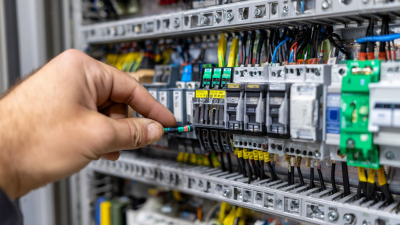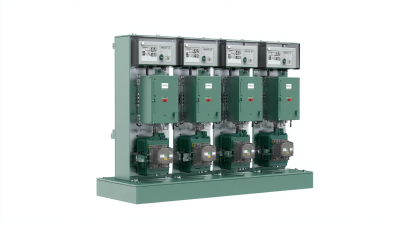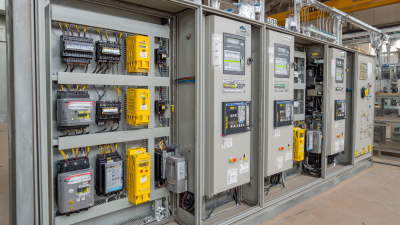Maximize Energy Efficiency with Vfd 1 Phase Solutions for Modern Applications
Table of Contents
- Understanding the Basics of VFD and Its Application in Modern Systems
- Identifying Energy Inefficiencies in One-Phase Equipment
- Selecting the Right VFD for Your One-Phase Energy Needs
- Installation and Configuration Tips for Optimal Performance
- Monitoring and Maintaining VFD Systems for Long-Term Efficiency
- Case Studies: Successful Implementation of VFD in Various Industries
- Exploring the Benefits and Applications of the General VFD 55kw 380V Motor Speed Controller Inverter Frequency Converter
- FAQS
- Conclusion
- Related Posts
These days, with the industrial world changing so fast, making sure we’re using energy efficiently has become more important than ever — not just for saving costs, but also for being sustainable. One solution that’s really catching on is VFD 1 Phase technology. It gives you that kind of precise control over motors, which is a big deal across all kinds of modern applications. Here at Zhejiang Chuanken Electric Co., Ltd., we’ve been working in this space for over 15 years — from research and development to manufacturing and sales of industrial automation products. We totally get how vital VFD 1 Phase solutions are for boosting operational efficiency.

By adopting these advanced systems, companies can cut down on energy use and boost performance at the same time — tackling both operational hurdles and environmental concerns. In this intro, I’ll chat about some practical strategies and tips to help you make the most of VFD 1 Phase tech, so your business can stay competitive and thrive in today’s market.
Understanding the Basics of VFD and Its Application in Modern Systems
Variable Frequency Drives (VFDs) are pretty essential when it comes to boosting energy efficiency in today’s setups. Basically, they tweak the output frequency and voltage to control motor speeds, which means they help cut down on energy use and save money in the long run. A report from the U.S. Department of Energy even mentions that adding VFDs to HVAC systems can slash energy consumption by anywhere from 20% to 50%. That’s a huge difference, especially for industries looking to be a bit more eco-friendly and cut costs. As more companies jump on the sustainability bandwagon, using VFD technology is really gaining popularity – it’s a pretty clear way to keep operations energy-efficient.
At Zhejiang Chuanken Electric Co., Ltd., we bring over 15 years of experience in designing and manufacturing industrial automation control products. We’re proud to offer high-quality VFD solutions that not only meet industry standards but also incorporate the latest tech. Whether it’s for manufacturing, pumping, or HVAC applications, our products are built to handle modern demands. With energy-saving solutions becoming more and more important, we’re committed to ongoing research and development, making sure our VFDs are ready to support the evolving needs of today’s industries while also doing our bit for a greener planet.
Identifying Energy Inefficiencies in One-Phase Equipment
Nowadays, really dialling up energy efficiency is more important than ever, especially when it comes to single-phase equipment. These systems often waste energy because they don’t have enough smart demand response features. A recent study points out that using cutting-edge tech—like adaptive reinforcement learning—can really help optimize energy management, especially in smart homes. Imagine combining clever algorithms like the Self-Adaptive Puma Optimizer Algorithm (SAPOA) with multi-objective deep learning approaches — the results can be pretty impressive, leading to big drops in energy use. Not only does this boost operational efficiency, but it also helps cut down on energy costs for households.

On top of that, there's also a lot of room for improvement when it comes to making single-phase systems more efficient, like liquid immersion cooling used for lithium-ion batteries. With electric vehicles becoming more popular, making sure these cooling systems are optimized is super important because they handle the power needs of non-road machinery like work machines. Industry reports suggest that, by adopting these energy-efficient solutions, we could see reductions in energy consumption of up to 30%. That’s a pretty huge step towards sustainable operation. Here at Zhejiang Chuanken Electric Co., Ltd., we’ve got strong expertise in industrial automation, and we’re excited to offer innovative products that help push these energy efficiency goals forward for one-phase systems.
Selecting the Right VFD for Your One-Phase Energy Needs
Choosing the right Variable Frequency Drive (VFD) for your one-phase energy setup isn't just about picking any model — there are a few important things to keep in mind to make sure you get the most out of it. First off, you wanna look at what your application actually needs in terms of power. Knowing the voltage and current specs is super helpful to make sure everything lines up with your existing equipment. Also, pay attention to how your load behaves — is it steady or does it change a lot? That can really influence which type of VFD will work best for you.

Another thing to consider is how the VFD controls things. Modern VFDs with torque or vector control modes tend to give better performance and efficiency — it’s worth the extra thought. Don’t forget about features like built-in protections, how easily the VFD can be integrated into your current setup, and whether it’s simple to operate. These little details can make a huge difference during daily operations. When you take all these factors into account, you'll end up with a VFD that not only fits your current energy needs but also can handle future growth, saving you money and making everything run smoother over the long haul.
Installation and Configuration Tips for Optimal Performance
When you're trying to get the most out of energy efficiency using a VFD (Variable Frequency Drive) with a single-phase setup, the way you install and set everything up really makes a difference. Honestly, taking the time to do it right can seriously boost how well your system performs. First off, make sure you pick the right VFD model that fits your specific needs. That means checking out things like motor specs, load type, and control requirements—don't just go for the cheapest or easiest option.
When you're installing it, keep an eye on wiring and be sure to follow safety rules—that’s super important to avoid any mishaps. Getting the sizing right isn't just about energy savings; it also helps your equipment last longer. Oh, and don’t forget about fine-tuning those settings! Tweak stuff like acceleration, deceleration, and torque limits so they match what your system actually needs. And the best part? Regularly monitoring how everything’s running and making small adjustments based on actual performance can keep your energy efficiency on point.
If you focus on these tips when installing and configuring your VFD, you'll be able to run it at its best, saving energy and improving overall performance in your setup.
Monitoring and Maintaining VFD Systems for Long-Term Efficiency
Keeping an eye on and maintaining your Variable Frequency Drive (VFD) systems is really important if you want things to run efficiently in the long run. Regular checks can help you catch any hiccups early—stuff like unexpected changes in motor speed or spikes in power use. Using modern monitoring tools can give you real-time updates on how your system’s doing, so you can quickly spot and fix issues before they become big problems. Staying on top of this kind of stuff can dramatically cut down on downtime and help your VFD and motors last longer, saving you some headaches down the line.
And honestly, proper maintenance is just as key. That means doing routine inspections, cleaning out components, and keeping the firmware up to date so things don’t slow down over time. Having a maintenance schedule in place helps you catch small issues before they turn into costly repairs. When you combine good monitoring with regular upkeep, you end up saving energy and cutting operational costs—which is a win for everyone.
All in all, this approach not only keeps your systems running smoothly but also makes your whole operation more sustainable and cost-effective over the long haul.
Case Studies: Successful Implementation of VFD in Various Industries
Variable Frequency Drives—aka VFDs—have really become game changers in a bunch of different industries. They help boost energy efficiency and overall operations. Take the manufacturing world, for example. There was this big automotive parts maker who decided to kit out their assembly line with VFDs. The cool thing? By tweaking motor speed and torque on the fly, based on what's actually needed at the moment, they managed to cut energy use by about 30%. Plus, they got faster production. So, not only did they save money on energy, but they also hit some sustainability targets. Pretty impressive, right?
Then there's the HVAC side of things. One huge commercial building installed VFDs to control fan speed dynamically as the load changed. The result? They slashed energy consumption by roughly 25%, all while keeping the climate just right and folks comfortable. The beauty of VFDs is that they make systems more responsive and efficient—no matter the industry. Seeing these real-world examples just goes to show how VFDs aren’t limited to one field; they’re super versatile when it comes to saving energy and boosting performance all around.
Exploring the Benefits and Applications of the General VFD 55kw 380V Motor Speed Controller Inverter Frequency Converter
The General VFD 55kw 380V Motor Speed Controller Inverter Frequency Converter, particularly the SHCKELE model SCK300, offers numerous advantages that cater to various industrial applications. With a robust design intended for general use, this inverter showcases exceptional efficiency in controlling motor speeds. The ability to adjust the frequency and voltage allows for precise control over motor performance, leading to increased energy savings and optimized operations. Industries ranging from manufacturing to HVAC can greatly benefit from enhanced motor control, resulting in reduced energy consumption and improved equipment lifespan.
One of the standout features of the SHCKELE SCK300 is its warranty of 18 months, reflecting the manufacturer's confidence in the product's reliability and performance. This inverter is not just versatile in application but is also designed to withstand challenging operational environments. Its user-friendly interface simplifies the setup and operation process, making it accessible for technicians and engineers alike. The integration of advanced technology ensures that this frequency converter can adapt to various load conditions, providing stability and efficiency where it's needed most.
FAQS
: Key factors include the power requirements of your application, voltage and current specifications, load characteristics (constant or variable), control methods (torque or vector control), built-in protection mechanisms, integration ease with existing systems, and user-friendly interfaces.
Proper installation involves selecting the right VFD model, ensuring correct wiring practices, sizing the VFD appropriately, and fine-tuning parameters like acceleration and torque limits. Regular monitoring and adjustments based on performance data are also crucial for sustained energy efficiency.
Load characteristics, whether constant or variable, influence the type of VFD chosen, impacting its performance and energy efficiency based on the specific application requirements.
Torque control or vector control methods are recommended for modern applications as they provide better performance and efficiency.
In a case study, an automotive parts manufacturer utilized VFDs on their assembly line, resulting in a 30% reduction in energy consumption while increasing production throughput.
A large commercial building implemented VFDs to optimize fan speed according to load conditions, achieving approximately 25% less energy usage while maintaining excellent climate control and occupant comfort.
The right VFD not only meets current energy needs but also scales with future demands, leading to long-term energy savings and improved operational performance.
Regular monitoring and adjustments based on performance data are essential for achieving and maintaining optimal energy efficiency in VFD operations.
Conclusion
Want to make your modern setups more energy-efficient? One pretty effective way is by using VFD 1 Phase solutions. Basically, this tech taps into the core ideas behind variable frequency drives (VFDs) and how they play a crucial role in getting one-phase equipment running smoothly in all sorts of industrial environments. When you spot where energy is wasted and pick the right VFD, your business can see big improvements in performance. Of course, getting these systems installed correctly and configured right is super important — that’s what makes sure everything runs at its best. And don’t forget, keeping an eye on things and doing regular maintenance really helps keep that efficiency going strong over time.
At Zhejiang Chuanken Electric Co., Ltd., we’re all about R&D in industrial automation controls. With 15 years of hands-on experience under our belt, we’ve seen firsthand how a well-implemented VFD 1 Phase system can make a difference. We’ve got case studies to back it up — showing real-world examples of how adopting these advanced VFD solutions can crank up energy savings and cut down operational costs across a bunch of different industries.
Related Posts
-

Essential Checklist for Global Buyers When Selecting 2 Phase VFD Solutions
-

How to Optimize Your Operations with Vfd Manual Best Practices for Increased Efficiency
-

Elevating Global Standards with Best 250 Kw Vfd Drive From China
-

Unlocking the Advantages of the Best 115kw Soft Starter for Your Business
-

Ultimate Guide to Selecting the Best 50Hz and 60Hz Soft Starters: Industry Insights and Strategies
-

Mastering the Installation of 250kw Soft Starters A Step by Step Guide for Global Buyers


